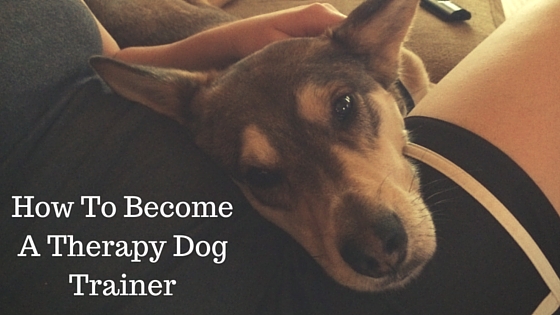
Therapy dogs are a growing population and there is a huge need for trainers and training classes to lead all those new volunteers. These are seven tips to become a therapy dog trainer.
Experience
Therapy dog trainers should have experience working a therapy dog in therapy situations. If your dog is not suitable, borrow a dog. Registered teams do not need to be traditional dog-owner teams; it just needs to be a dog you have a relationship with and will work with you. While you can’t possibly offer your students a full spectrum of experiences, it is important to be able to offer them some. (Therapy dog visits are always new and changing – that’s why it is important for teams to be flexible and accommodating to new situations, environments, people, etc.)
Registering Organizations
Therapy dog trainers should be familiar with the prevalent/popular registering organizations in your area: their insurance policies, their testing requirements, policies and procedures, their equipment requirements, and what is expected and prohibited on visits. Ideally, be a part of at least one of them as a team, as a supporter, or as an evaluator. Being familiar with the organizations and their guidelines will help you know what is required (or prohibited) and will help you determine what and how to teach. (It is important that therapy dog teams are registered and insured with a reputable organization. Many facilities require it. If there is an incident and the team is not registered/insured, it falls to homeowners/rental policies and can be financially devastating.)
Think outside the box!
Therapy dog work is no longer limited to nursing homes and libraries. There are therapy dog teams in a wide variety of locations and situations – hospitals, rehab centers, physical therapy centers, dentist offices, psychologist/psychiatrists’ offices, social workers, schools at all levels and abilities, colleges, various work places, court rooms, depositions, lawyers’ offices, funeral homes, hospices, after school programs, etc. So while a dog and handler may not fit a “traditional” therapy dog mold, they may fit into one of the less traditional therapy dog opportunities available to teams.
A Team Effort
It is important that therapy dog handlers understand that doing therapy dog work is a TEAM effort – both the human and the dog need training and preparation to be their most effective and successful. Challenging the handlers in your classes is important – handlers should be able to appropriately handle different situations in different environments as well as being the best possible handler and advocate for their dogs while visiting.
Be creative in your teaching!
Use lots of different props and equipment. Challenge both the humans and the dogs. Expect and require full participation from teams. Go on field trips. Utilize the information and curriculum available for both the Canine Good Citizen and the Canine Life and Social Skills evaluations. Invite lots of different people to come and help in your therapy dog class. Therapy dog teams cannot be over-prepared.
Foundations
Foundation behaviors are important in therapy dog work. A solid foundation will set teams up for success as well as giving them something to fall back on when a strange, unique, or unexpected situation arises while doing therapy dog work. Heavily reinforce the foundation. Incorporate exercises and games into your curriculum that incorporate foundation behaviors – focus/attention, touch, sit, down, stand, stay, polite leash walking, handling, greetings, and mat work. Distance is not important in a therapy dog class as most registrations require the handler always have their dog on a leash and the leash in the handler’s hand. But duration and distractions are very important!
Support
Ongoing support and training is important for therapy dog teams. Offering teams regular access to a trainer and opportunities to continue and maintain their training is reassuring and encourages teams to continue to train and mature as a team.
Being a therapy dog team is very rewarding; being their instructor/trainer is priceless. Teaching therapy dog teams may take a bit more preparation, but the positive results will far outweigh the investment of time and energy. What is your favorite out-of-the-box teaching tool?
Get Dog Training Business Tips!
Receive valuable dog training business tips and resources every week! Subscribe to The Modern Dog Trainer now by submitting your name and email below.
[mc4wp_form]



